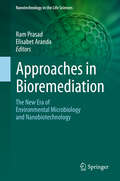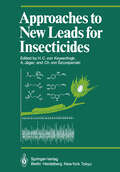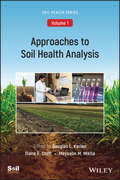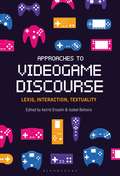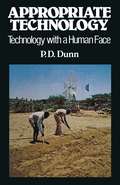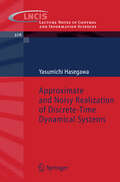- Table View
- List View
Approaches for Enhancing Abiotic Stress Tolerance in Plants
by Edited by Mirza Hasanuzzaman Kamrun Nahar Masayuki Fujita Hirosuke Oku M. Tofazzal IslamPlants are frequently exposed to unfavorable and adverse environmental conditions known as abiotic stressors. These factors can include salinity, drought, heat, cold, flooding, heavy metals, and UV radiation which pose serious threats to the sustainability of crop yields. Since abiotic stresses are major constraints for crop production, finding the approaches to enhance stress tolerance is crucial to increase crop production and increase food security. This book discusses approaches to enhance abiotic stress tolerance in crop plants on a global scale. Plants scientists and breeders will learn how to further mitigate plant responses and develop new crop varieties for the changing climate.
Approaches for Enhancing Abiotic Stress Tolerance in Plants
by Mirza Hasanuzzaman Masayuki Fujita Tofazzal Islam Kamrun Nahar Hirosuke OkuPlants are frequently exposed to unfavorable and adverse environmental conditions known as abiotic stressors. These factors can include salinity, drought, heat, cold, flooding, heavy metals, and UV radiation which pose serious threats to the sustainability of crop yields. Since abiotic stresses are major constraints for crop production, finding the approaches to enhance stress tolerance is crucial to increase crop production and increase food security. This book discusses approaches to enhance abiotic stress tolerance in crop plants on a global scale. Plants scientists and breeders will learn how to further mitigate plant responses and develop new crop varieties for the changing climate.
Approaches for Potato Crop Improvement and Stress Management
by John E. Bradshaw S. M. Paul Khurana Vinay BhardwajThis edited book provides an all-inclusive coverage of latest research in crop improvement and stress management in potato crop. It is composed of 17 chapters covering breeding, diseases & pest management with the view to enhancing the total production and quality under the scenario of climate change. The book also explores harvesting, storage, post-harvest management, and processing of potato. The book has special focus on the use of high throughput next generation sequencing (NGS) techniques, modern genomics tools, genome editing techniques such as CRISPR systems that could help the potato breeding programs and, also in development of biotic and abiotic stress resistant varieties. Potato is the world’s third most important food crop after wheat and rice in terms of human consumption. It is the staple crop providing maximum nutrients per unit area, time and money and is the most versatile crop with the highest industrial production potential in India being the second largest potato producing country after China. As a major food crop, the potato has the most important role to play in the United Nations’ Sustainable Development Goals’ 2030 Agenda for zero hunger, achieving food security, improved nutrition, and promote sustainable agriculture. This book is unique in its approach for providing in depth knowledge enabling readers to learn the subject fully on different strategies, new perspectives and fully understanding different topics of diversity, interaction and improvement for stress management in potato. It is a relevant reading material for researchers, students, practitioners and other stakeholders involved in improvement of potato crop.
Approaches in Bioremediation: The New Era of Environmental Microbiology and Nanobiotechnology (Nanotechnology in the Life Sciences)
by Ram Prasad Elisabet ArandaBioremediation refers to the clean‐up of pollution in soil, groundwater, surface water, and air using typically microbiological processes. It uses naturally occurring bacteria and fungi or plants to degrade, transform or detoxify hazardous substances to human health or the environment.For bioremediation to be effective, microorganisms must enzymatically attack the pollutants and convert them to harmless products. As bioremediation can be effective only where environmental conditions permit microbial growth and action, its application often involves the management of ecological factors to allow microbial growth and degradation to continue at a faster rate. Like other technologies, bioremediation has its limitations. Some contaminants, such as chlorinated organic or high aromatic hydrocarbons, are resistant to microbial attack. They are degraded either gradually or not at all, hence, it is not easy to envisage the rates of clean-up for bioremediation implementation.Bioremediation represents a field of great expansion due to the important development of new technologies. Among them, several decades on metagenomics expansion has led to the detection of autochthonous microbiota that plays a key role during transformation. Transcriptomic guides us to know the expression of key genes and proteomics allow the characterization of proteins that conduct specific reactions. In this book we show specific technologies applied in bioremediation of main interest for research in the field, with special attention on fungi, which have been poorly studied microorganisms. Finally, new approaches in the field, such as CRISPR-CAS9, are also discussed. Lastly, it introduces management strategies, such as bioremediation application for managing affected environment and bioremediation approaches. Examples of successful bioremediation applications are illustrated in radionuclide entrapment and retardation, soil stabilization and remediation of polycyclic aromatic hydrocarbons, phenols, plastics or fluorinated compounds. Other emerging bioremediation methods include electro bioremediation, microbe-availed phytoremediation, genetic recombinant technologies in enhancing plants in accumulation of inorganic metals, and metalloids as well as degradation of organic pollutants, protein-metabolic engineering to increase bioremediation efficiency, including nanotechnology applications are also discussed.
Approaches, Opportunities, and Challenges for Eco-design 4.0: A Concise Guide for Practitioners and Students
by Samira KeivanpourThis book addresses the implications of the Industry 4.0 paradigm in design for the environment. We examine the opportunities for, and challenges of, the implications of cyber-physical systems, big data analytics, Internet of things, additive manufacturing, and simulation in a range of areas in an eco-design context. These include selecting low impact materials, choosing manufacturing processes with environmental considerations, end of life strategies, applying design approaches for disassembly, integrating economic and social components into environmental studies, and stakeholder’s involvement. This volume takes a step toward this journey to explore how the three pillars of technology, sustainability, and evolving consumers could shape the future of the product’s design.
Approaches to Enhance Industrial Production of Fungal Cellulases (Fungal Biology)
by Manish Srivastava Neha Srivastava Pramod W. Ramteke Pradeep Kumar MishraCellulase is a key enzyme of industrial interest and plays a crucial role in the hydrolysis of cellulose, a prime component of plant cell walls. Cellulase covers a broad area in the global market of industrially important enzymes and it is considered as the third largest industrial enzyme globally. Additionally, cellulase contributes about 20% of the total enzyme market globally because of its massive demand in various industries such as in biofuel production, pulp, paper, textile, food, and beverages, as well as in detergent industries. Among these, the demand of cellulase may become frequently selected in the commercial production of biofuels in the future and thus will further increase demand of cellulase in the biofuel industry. Because biofuel production is still not realized in a cost-effective, practical implementation due to its high cost (the higher cost of biofuels is due to higher production costs of enzymes), there is a need to introduce these types of approaches, which will help to lower the cost of enzyme production for developing overall economic biofuel production.
Approaches to Entropy
by Jeremy R. TameThis is a book about thermodynamics, not history, but it adopts a semi-historical approach in order to highlight different approaches to entropy. The book does not follow a rigid temporal order of events, nor it is meant to be comprehensive. It includes solved examples for a solid understanding. The division into chapters under the names of key players in the development of the field is not intended to separate these individual contributions entirely, but to highlight their different approaches to entropy. This structure helps to provide a different view-point from other text-books on entropy.
Approaches to Heavy Metal Tolerance in Plants
by Sumira Jan Javid Ahmad ParrayThis book summarizes the development of highly tolerant cultivars via plant breeding, genomics, and proteomic approaches. This book could supplement data for budding researchers by providing extensive ongoing measures to improve the detoxification competence of appropriate species via wide range of plant improvement approaches. It also offers insights into heavy metal signalling,metal chelation by organic acids, amino acids, and phosphate derivatives, and illustrates other strategies that have been extensively investigated, such as genetic engineering, ecological improvement of the rhizosphere using mycorrhiza and chelator enhanced phytoremediation technology. This book could provide simple anthology for undergraduate and postgraduate students to understand fundamentals of heavy metal pollution in the environment. The book closes with a prelude to an inclusive study of biodiversity that could provide new biofilters for metal detoxification.
Approaches to Modeling of Friction and Wear: Proceedings of the Workshop on the Use of Surface Deformation Models to Predict Tribology Behavior, Columbia University in the City of New York, December 17–19, 1986
by Frederick F. Ling C. H. T. PanAt the conclusion of the Conference on Tribology in the area of Wear Life Pre diction of Mechanical Components, which was held at the General Motors Research Laboratories and sponsored by the Industrial Research Institute, a very high pri ority recommendation was modeling of tribological systems. Since the appearance of the Conference Proceedings in 1985, the writers discussed the matter of modeling with Dr. Edward A. Saibel, Chief of the Solid Mechanics Branch, Engineering Sciences Division, U.S. Army Research Office. This discussion led to a proposal for the Workshop which resulted in this volume. The choice of proposal and Workshop name turned out to be more restricted than it needed to be. As such, the Workshop adopted the name for this volume, Approaches to Modeling of Friction and Wear. By design, the attendance was restricted to not more than 40 individuals so as to allow small group discussions. There were four panels which deliberated on the same questions after two invited area lectures. Section 1 contains the substance of the two lectures. Section 2 is the Workshop Summary which is a distillation of the four panel reports by the entire Workshop attendance. This was formally written up and edited by the eight panel session chairmen, i.e., each of the four panels met twice on two different questions under the leadership of a chairman for each session. Section 3 contains four brief position papers on the subject of the Workshop.
Approaches to New Leads for Insecticides (Proceedings in Life Sciences)
by Harald C. V. Keyserlingk Albert Jäger Christoph V. SzczepanskiApproaches to Plant Stress and their Management
by R. K. Gaur Pradeep SharmaPlant stresses are serious threats to the sustainability of crop yields accounting for more crop productivity losses than any other factor in rainfed agriculture. Post-harvest losses mean surplus crops do not reach market, affecting the livelihoods of farming families, and too often these families are left with no other option than to eat contaminated stored food. These constraints impact the food security of these farming families as well as the communities and countries in which they live. This book is the demonstration of a clear synergistic effect of stresses, an effect that was unexpectedly as important as either stress applied alone. This book will add to our current knowledge of abiotic stress response in plants and will provide the groundwork necessary to build future strategies for crop enhancement. The fundamental principles that underpin all biotechnology are explained and a full range of examples discussed to show how these principles are applied; from starting substrate to final product. It will be beneficial to both plant breeders and molecular biologists, because it combines the topics of physiology, tolerance genes, and breeding methods. When these topics are presented together, it is easy to compare all aspects of tolerance mechanisms and breeding methods for abiotic stresses. These comparisons are useful to understand which pathways or which genes are important for rendering more tolerance to a certain abiotic stress, and to bring forward new ideas for improving the tolerance. Features •Cover both plant biotic and abiotic stresses •Important factors in managing crops for water stress conditions •Substantially increase the sustainable productivity of smallholder farmers in developing countries •Genetic and biochemical approaches – if those approaches constitute a substantial improvement on current practices.
Approaches to Probabilistic Model Learning for Mobile Manipulation Robots (Springer Tracts in Advanced Robotics #89)
by Jürgen SturmThis book presents techniques that enable mobile manipulation robots to autonomously adapt to new situations. Covers kinematic modeling and learning; self-calibration; tactile sensing and object recognition; imitation learning and programming by demonstration.
Approaches to Soil Health Analysis, Volume 1 (ASA, CSSA, and SSSA Books)
by Douglas L. Karlen Diane E. Stott Maysoon M. MikhaApproaches to Soil Health Analysis A concise survey of soil health analysis and its various techniques and applications The maintenance of healthy soil resources provides the foundation for an array of global efforts and initiatives that affect humanity. Whether they are working to combat food shortages, conserve our ecosystems, or mitigate the impact of climate change, researchers and agriculturalists the world over must be able to correctly examine and understand the complex nature of this essential, fragile resource. These new volumes have been designed to meet this need, addressing the many dimensions of soil health analysis in chapters that are concise, accessible and applicable to the tasks at hand. Soil Health, Volume One: Approaches to Soil Health Analysis provides a well-rounded overview of the various methods and strategies available to analysists, and covers topics including: The history of soil health and its studyChallenges and opportunities facing analysistsMeta-data and its assessmentApplications to forestry and urban land reclamationFuture soil health monitoring and evaluation approaches Offering a far-reaching survey of this increasingly interdisciplinary field, this volume will be of great interest to all those working in agriculture, private sector businesses, non-governmental organizations (NGOs), academic-, state-, and federal-research projects, as well as state and federal soil conservation, water quality and other environmental programs.
Approaches to Soil Health Analysis, Volume 1 (ASA, CSSA, and SSSA Books)
by Douglas L. Karlen Diane E. Stott Maysoon M. MikhaApproaches to Soil Health Analysis A concise survey of soil health analysis and its various techniques and applications The maintenance of healthy soil resources provides the foundation for an array of global efforts and initiatives that affect humanity. Whether they are working to combat food shortages, conserve our ecosystems, or mitigate the impact of climate change, researchers and agriculturalists the world over must be able to correctly examine and understand the complex nature of this essential, fragile resource. These new volumes have been designed to meet this need, addressing the many dimensions of soil health analysis in chapters that are concise, accessible and applicable to the tasks at hand. Soil Health, Volume One: Approaches to Soil Health Analysis provides a well-rounded overview of the various methods and strategies available to analysists, and covers topics including: The history of soil health and its studyChallenges and opportunities facing analysistsMeta-data and its assessmentApplications to forestry and urban land reclamationFuture soil health monitoring and evaluation approaches Offering a far-reaching survey of this increasingly interdisciplinary field, this volume will be of great interest to all those working in agriculture, private sector businesses, non-governmental organizations (NGOs), academic-, state-, and federal-research projects, as well as state and federal soil conservation, water quality and other environmental programs.
Approaches to Videogame Discourse: Lexis, Interaction, Textuality
by Astrid Ensslin Isabel BalteiroThe first significant collection of research in videogame linguistics, Approaches to Videogame Discourse features an international array of scholars in linguistics and communication studies exploring lexis, interaction and textuality in digital games. In the first section, “Lexicology, Localisation and Variation,” chapters cover productive processes surrounding gamer slang (ludolects), creativity and borrowing across languages, as well as industry-, genre-, game- and player-specific issues relating to localization, legal jargon and slang. “Player Interactions” moves on to examine communicative patterns between videogame players, focusing in particular on (un)collaborative language, functions and negotiations of impoliteness and issues of power in player discourse. In the final section, “Beyond the 'Text',” scholars grapple with issues of multimodality, paratextuality and transmediality in videogames in order to develop and enrich multimodal theory, drawing on key concepts from ludonarratology, language ideology, immersion and transmedia studies. With implications for meaningful game design and communication theory, Approaches to Videogame Discourse examines in detail how video games function as means and objects of communication; how they give rise to new vocabularies, textual genres and discourse practices; and how they serve as rich vehicles of ideological signification and social engagement.
Approaches to Videogame Discourse: Lexis, Interaction, Textuality
by Astrid Ensslin Isabel BalteiroThe first significant collection of research in videogame linguistics, Approaches to Videogame Discourse features an international array of scholars in linguistics and communication studies exploring lexis, interaction and textuality in digital games. In the first section, “Lexicology, Localisation and Variation,” chapters cover productive processes surrounding gamer slang (ludolects), creativity and borrowing across languages, as well as industry-, genre-, game- and player-specific issues relating to localization, legal jargon and slang. “Player Interactions” moves on to examine communicative patterns between videogame players, focusing in particular on (un)collaborative language, functions and negotiations of impoliteness and issues of power in player discourse. In the final section, “Beyond the 'Text',” scholars grapple with issues of multimodality, paratextuality and transmediality in videogames in order to develop and enrich multimodal theory, drawing on key concepts from ludonarratology, language ideology, immersion and transmedia studies. With implications for meaningful game design and communication theory, Approaches to Videogame Discourse examines in detail how video games function as means and objects of communication; how they give rise to new vocabularies, textual genres and discourse practices; and how they serve as rich vehicles of ideological signification and social engagement.
Approaching Human Performance: The Functionality-Driven Awiwi Robot Hand (Springer Tracts in Advanced Robotics #98)
by Markus GrebensteinHumanoid robotics have made remarkable progress since the dawn of robotics. So why don't we have humanoid robot assistants in day-to-day life yet? This book analyzes the keys to building a successful humanoid robot for field robotics, where collisions become an unavoidable part of the game. The author argues that the design goal should be real anthropomorphism, as opposed to mere human-like appearance. He deduces three major characteristics to aim for when designing a humanoid robot, particularly robot hands:- Robustness against impacts- Fast dynamics- Human-like grasping and manipulation performanceInstead of blindly copying human anatomy, this book opts for a holistic design methodology. It analyzes human hands and existing robot hands to elucidate the important functionalities that are the building blocks toward these necessary characteristics. They are the keys to designing an anthropomorphic robot hand, as illustrated in the high performance anthropomorphic Awiwi Hand presented in this book.This is not only a handbook for robot hand designers. It gives a comprehensive survey and analysis of the state of the art in robot hands as well as the human anatomy. It is also aimed at researchers and roboticists interested in the underlying functionalities of hands, grasping and manipulation.The methodology of functional abstraction is not limited to robot hands, it can also help realize a new generation of humanoid robots to accommodate a broader spectrum of the needs of human society.
Appropriate Technologies for Environmental Protection in the Developing World: Selected Papers from ERTEP 2007, July 17-19 2007, Ghana, Africa
by Ernest K. YanfulThis book is the first edited compilation of selected, refereed papers submitted to ERTEP 2007. The selected papers either dealt with technologies or scientific work and policy findings that address specific environmental problems affecting humanity in general, but more specifically, people and ecosystems in developing countries. It was not necessary for the work to have been done in a developing country, but the findings and results must be appropriate or applicable to a developing country setting. It is acknowledged that environmental research, technology applications and policy implementation have been demonstrated to improve environmental sustainability and protection in several developed economies. The main argument of the book is that similar gains can be achieved in developing economies and economies in transition. The book is organized into six chapters along some of the key themes discussed at the conference: Environmental Health Management, Sustainable Energy and Fuel, Water Treatment, Purification and Protection, Mining and Environment, Soil Stabilization, and Environmental Monitoring. It is hoped that the contents of the book will provide an insight into some of the environmental and health mana- ment challenges confronting the developing world and the steps being taken to address them.
Approximate Analysis of Stochastic Processes in Mechanics: Course Held at the Department of General Mechanics October 1971 (CISM International Centre for Mechanical Sciences #95)
by Josef L. ZemanApproximate and Noisy Realization of Discrete-Time Dynamical Systems (Lecture Notes in Control and Information Sciences #Vol. 376)
by Yasumichi HasegawaThis monograph deals with approximation and noise cancellation of dynamical systems which include linear and nonlinear input/output relations. It will be of special interest to researchers, engineers and graduate students who have specialized in ?ltering theory and system theory. From noisy or noiseless data, reductionwillbemade.Anewmethodwhichreducesnoiseormodelsinformation will be proposed. Using this method will allow model description to be treated as noise reduction or model reduction. As proof of the e?cacy, this monograph provides new results and their extensions which can also be applied to nonlinear dynamical systems. To present the e?ectiveness of our method, many actual examples of noise and model information reduction will also be provided. Using the analysis of state space approach, the model reduction problem may have become a major theme of technology after 1966 for emphasizing e?ciency in the ?elds of control, economy, numerical analysis, and others. Noise reduction problems in the analysis of noisy dynamical systems may havebecomeamajorthemeoftechnologyafter1974foremphasizinge?ciencyin control.However,thesubjectsoftheseresearcheshavebeenmainlyconcentrated in linear systems. In common model reduction of linear systems in use today, a singular value decompositionofaHankelmatrixisusedto?ndareducedordermodel.However, the existence of the conditions of the reduced order model are derived without evaluationoftheresultantmodel.Inthecommontypicalnoisereductionoflinear systems in use today, the order and parameters of the systems are determined by minimizing information criterion. Approximate and noisy realization problems for input/output relations can be roughly stated as follows: A. The approximate realization problem. For any input/output map, ?nd one mathematical model such that it is similar totheinput/outputmapandhasalowerdimensionthanthegivenminimalstate spaceofadynamicalsystemwhichhasthesamebehaviortotheinput/outputmap. B. The noisy realization problem.
Approximate Antenna Analysis for CAD
by Hubregt J. VisserThis step-by-step guide provides the reader with a detailed and thorough introduction to practical antenna design and model implementation In this book, Hubregt J. Visser provides an introduction to the fundamentals of antenna design and the implementation of design models. A variety of antennas for wireless applications and communications systems are explained, and the real-life use of the antennas is demonstrated through extensive use of application examples. The author includes discussions on the design process of several antennas, such as intravascular MR Antennas, PCB antennas, RFID antennas, rectennas etc. Furthermore, emphasis is placed on Computer Aided Design (CAD) using approximated models. Key Features Includes coverage on intravascular MR Antennas, PCB antennas, RFID antennas, rectennas, etc Comprehensively details the application areas, modeling, analysis, and validation processes for individual antennas Discusses the use of equivalent dipole antennas, equivalent transmission line networks and electrostatics Introduces many antennas and models that have not been covered in previous publications (such as MRI Antennas, for example) This book will be of interest to microwave and antenna engineers. Graduate and post-graduate antennas students studying BSc and MSc courses, as well as research assistants will also find this book insightful.
Approximate Arithmetic Circuit Architectures for FPGA-based Systems
by Salim Ullah Akash KumarThis book presents various novel architectures for FPGA-optimized accurate and approximate operators, their detailed accuracy and performance analysis, various techniques to model the behavior of approximate operators, and thorough application-level analysis to evaluate the impact of approximations on the final output quality and performance metrics. As multiplication is one of the most commonly used and computationally expensive operations in various error-resilient applications such as digital signal and image processing and machine learning algorithms, this book particularly focuses on this operation. The book starts by elaborating on the various sources of error resilience and opportunities available for approximations on various layers of the computation stack. It then provides a detailed description of the state-of-the-art approximate computing-related works and highlights their limitations.
Approximate Circuits: Methodologies And Cad
by Sherief Reda Muhammad ShafiqueThis book provides readers with a comprehensive, state-of-the-art overview of approximate computing, enabling the design trade-off of accuracy for achieving better power/performance efficiencies, through the simplification of underlying computing resources. The authors describe in detail various efforts to generate approximate hardware systems, while still providing an overview of support techniques at other computing layers. The book is organized by techniques for various hardware components, from basic building blocks to general circuits and systems.
Approximate Computing
by Weiqiang Liu Fabrizio LombardiThis book explores the technological developments at various levels of abstraction, of the new paradigm of approximate computing. The authors describe in a single-source the state-of-the-art, covering the entire spectrum of research activities in approximate computing, bridging device, circuit, architecture, and system levels. Content includes tutorials, reviews and surveys of current theoretical/experimental results, design methodologies and applications developed in approximate computing for a wide scope of readership and specialists.Serves as a single-source reference to state-of-the-art of approximate computing;Covers broad range of topics, from circuits to applications;Includes contributions by leading researchers, from academia and industry.


